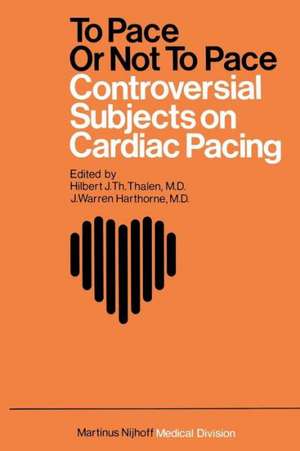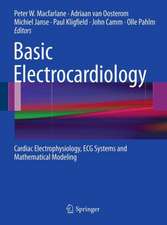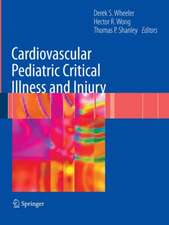To Pace or not to Pace: Controversial Subjects in Cardiac Pacing
Editat de Hilbert J.Th. Thalen, J.W. Harthorneen Limba Engleză Paperback – 25 feb 2012
Preț: 380.61 lei
Preț vechi: 400.65 lei
-5% Nou
Puncte Express: 571
Preț estimativ în valută:
72.83€ • 76.04$ • 60.28£
72.83€ • 76.04$ • 60.28£
Carte tipărită la comandă
Livrare economică 04-18 aprilie
Preluare comenzi: 021 569.72.76
Specificații
ISBN-13: 9789400997257
ISBN-10: 9400997256
Pagini: 512
Ilustrații: 480 p.
Dimensiuni: 155 x 235 x 27 mm
Greutate: 0.71 kg
Ediția:Softcover reprint of the original 1st ed. 1978
Editura: SPRINGER NETHERLANDS
Colecția Springer
Locul publicării:Dordrecht, Netherlands
ISBN-10: 9400997256
Pagini: 512
Ilustrații: 480 p.
Dimensiuni: 155 x 235 x 27 mm
Greutate: 0.71 kg
Ediția:Softcover reprint of the original 1st ed. 1978
Editura: SPRINGER NETHERLANDS
Colecția Springer
Locul publicării:Dordrecht, Netherlands
Public țintă
ResearchCuprins
Opening.- Opening Address.- Official Opening.- Section I. Conduction System.- The Normal Anatomy of the Sinus Node and its Pathology.- Evaluation of the Cardiac Conduction System by His Bundle Recordings.- Significance of His Bundle Recording in Bundle Branch Block.- Satrap: A Computer Study of His Bundle Potentials Obtained by a Non-invasive Method.- A Technique for Non-Invasive His-Purkinje System (HPS) Recording.- Discussion.- Section II. To Pace or not to Pace.- Cardiac Pacing in Sick Sinus Syndrome.- Cardiac Pacing in Fascicular Block.- Cardiac Pacing in Acute Myocardial Infarction.- Prophylactic Preoperative Pacing.- Cardiac Pacing in Open Heart Surgery.- Discussion.- Section III. Energy Sources and Electronic Circuit.- Pacemaker Energy Sources, Old and New.- The Saft Lithium-Silver Chromate Battery: Performances of the Li 210 Type.- The Lithium-Iodine Cell.- The Lithium Pacemaker, a Four-Year Clinical Experience.- New Pacemaker Devices from a Technical Point of View.- New Pacemaker Circuitry from a Clinical Point of View.- End-of-Life Indications for Lithium Pacemakers.- Discussion.- Section IV. Stimulation Electrodes.- A. Atrial Electrodes.- Transmediastinal and Transthoracic Atrial Electrodes.- The Use of Coronary Sinus Pacing.- Permanent Atrial Electrodes with Special Consideration to Transvenous Endocardial Forms.- B. Ventricular Electrodes.- Results of 57 Cases with MIP 2000 Endocardial Electrode, Compared with a Series of 1200 Endocardial Electrodes.- Clinical Results with Intramural and Endocardial Electrodes Implanted for over 8 Years.- Long-term Experience with an Endocardial Screw-in Electrode.- Permanent Endocardial Pacing without Electrode Dislodgement?.- Discussion.- Section V. The Choice of the Pacemaker-Electrode Combination.- The Pacemaker-Electrode Combination and Its Relationship to Service Life.- The Choice of the Pacemaker-Electrode Combination: Clinical Implications in Paroxysmal Arrhythmias.- The Choice of the Electrode and Pacing Method for Emergency Cardiac Pacing.- Round Table.- Round Table Discussion: The Choice of the Pacemaker-Electrode Combination.- Section VI. Pacemaker Implantation: Surgeon and/or Cardiologist.- The Cooperation in Management of Pacemaker Patients.- The Teamwork in Pacemaker Implantation.- Who Should Implant a Pacemaker System, Cardiologist or Surgeon?.- The Surgeon, Who Selects and Implants?.- Discussion.- Section VII. Pacemaker Electrocardiography.- ECG Survey of Various Pacemaker Modes.- Pacemaker Electrocardiography — the Importance of QRS and T wave Configuration.- Electrocardiographic Diagnosis of Myocardial Infarction and Coronary Insufficiency in the Pacemaker Patient.- The Irregular Pacemaker: Mechanisms and Clinical Significance.- Complex Demand Pacemaker Arrhythmias: The Differential Diagnosis of Pacemaker Pauses.- Electrocardiographic Patterns in Sick Sinus Syndrome.- Discussion.- Section VIII. Tarchycardia and Pacing.- Diagnostic Pacing in Tachycardia.- Pacing in Supraventricular Tachycardia.- Risks of Delayed Potentials in Pacemaker Patients Prone to Ventricular Tachycardia.- A Special Approach in the Management of Re-entry Tachycardias.- Discussion.- Section IX. Pacemaker Follow-up Methods.- Pacemaker Follow-up Methods.- Significance of Photoanalysis in a Pacemaker Surveillance System.- Pacemaker Failure Detectable by Rontgen Analysis.- Transtelephone Pacemaker Monitoring.- Pacemaker Follow-up by a Self-Check system.- Discussion.- Section X. Computer Application in Pacemaker Registration and Follow-up.- Computer Applications for the Control of Pacemaker Patients:Remarks and Personal Experience.- Computer Storage of Pacemaker Data.- Storage, Evaluation and Application of Data in a Pacemaker Clinic.- Digital Computers in Pacemaker Analysis.- The National Pacemaker Databank.- Impulse Analyser-Computer Interface: A New Way to Store Pacemaker Data.- The Significance in Quality Control of a Computer for Production- and Field-Data. Complete Traceability, possible or not?.- Discussion.- Round Table Discussion.- The Pacemaker Clinic: Organization and Patient Load.- Official Closure.- Importance of Colloquium for the Clinician.- Importance of Colloquium for Research and Development.- Closure.- Farewell.







